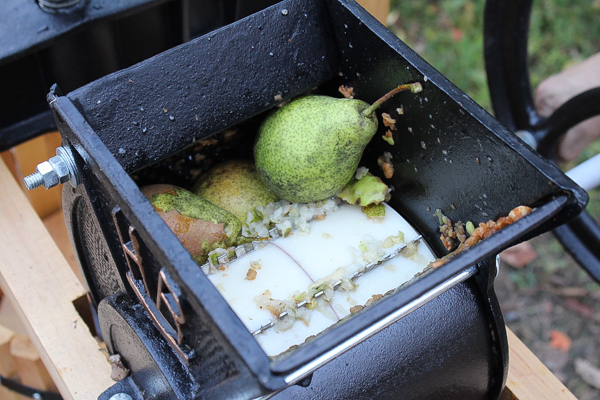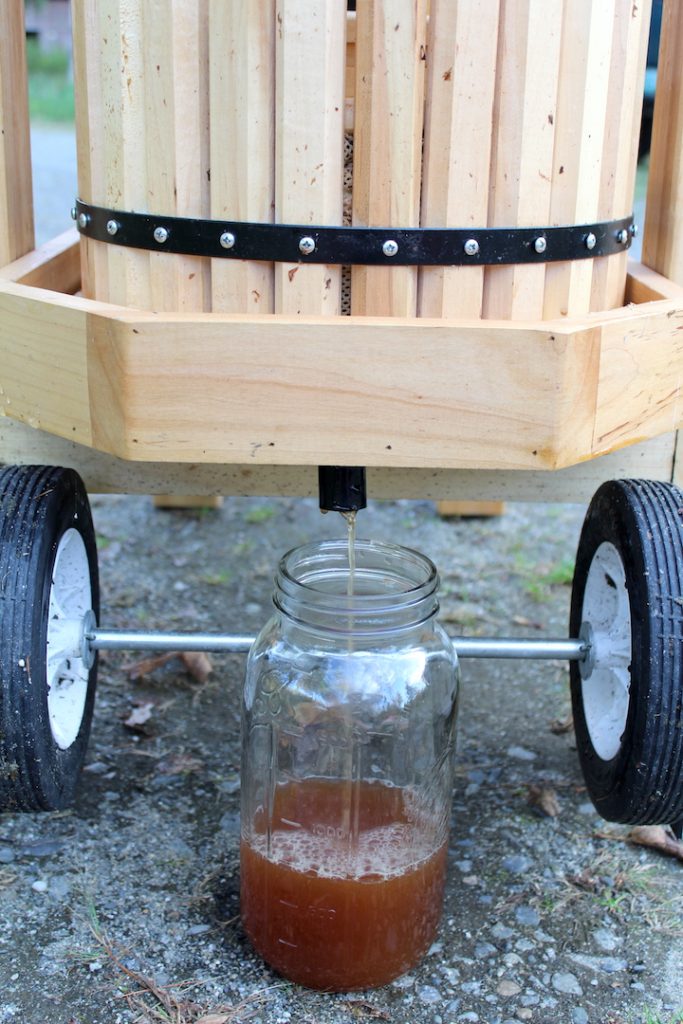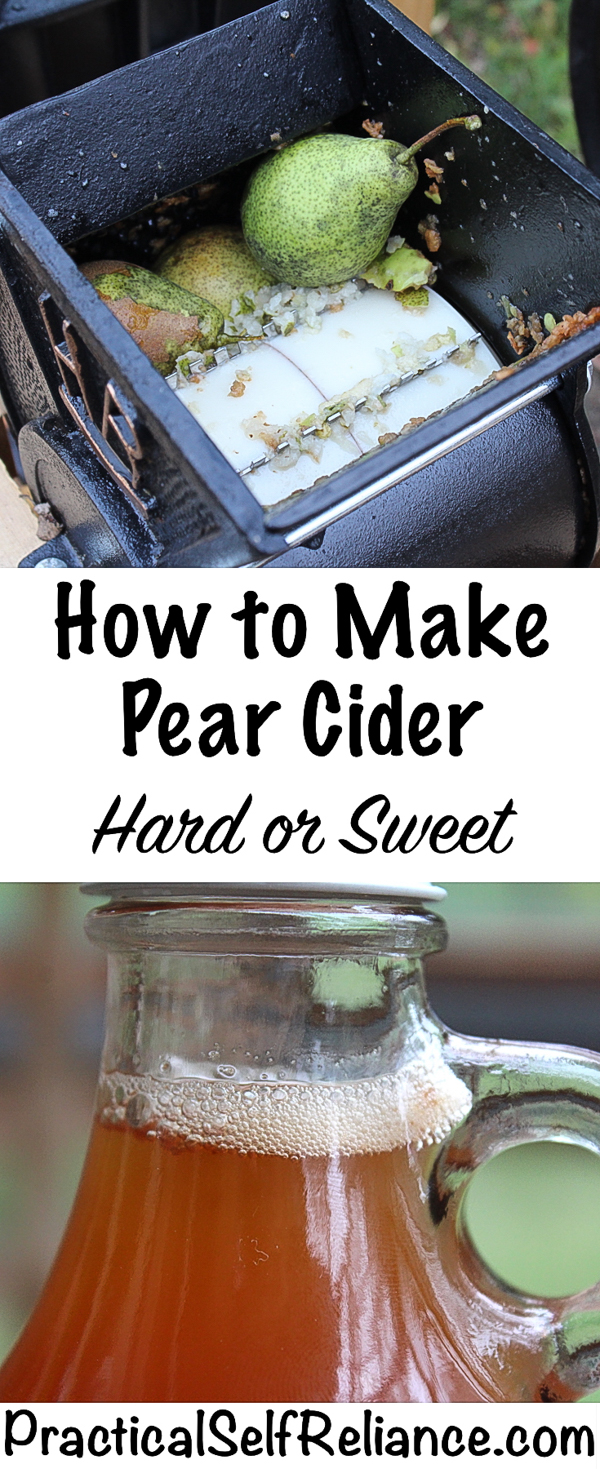Affiliate disclosure: This post may contain affiliate links. Please see our Privacy Policy.
Autumn is cider season, but that means more than apple cider. Pear cider is a delicious way to enjoy the season and preserve pears at the same time.
While the process of making pear cider is similar to making apple cider, the taste is as unique as a pear itself. Whether you enjoy pear cider fresh or ferment it into hard pear cider (known as perry), it’s well worth the effort.

How to Make Sweet Pear Cider
Regardless of whether it’s made of apples or pears, cider is made from raw unfiltered juice. Since the juice is pressed fresh, it’ll quickly oxidize and give that characteristic brown color we all know and love from apple cider. Looking at a cup of cider, you won’t know if it’s apple or pear until you taste it.
Once you taste it though, the full flavor of the pears shines through and it’d be hard to mistake pear cider for apple cider.

The trick to making good pear cider is finding good pears. Orchards that produce apple cider commercially need to create a blend of juices, adding different types of apples for the right sweetness, acidity, and body. The juices of the intensely sweet dessert apples we eat fresh make a pretty one-dimensional juice, and the same is true of the table pears we know and love.
Avoid super sweet pears like Bartlett, and ideally, see if you can find an old pear tree from a forgotten variety. Most pear varieties don’t keep long, and you can only eat so many fresh pears before they spoil.
Old-time trees were often selected to make good pear cider, and they’ll have more tartness and acidity. Look for that old pear tree along the sidewalk that’s just dropping fruit and making a mess, and ask the owner of the house if you can clean it up for them. Double win!

If you can only get a hold of super sweet dessert pears, consider adding other fruit for a bit of tart balance. Fall raspberries are a good choice or just a little lemon juice in a pinch.
Regardless of the pears you use, it’s important to press them raw. That’s what makes for cider after all.
We press our homegrown pears on a super efficient double barrel cider press. While one person is pressing the first batch, another is grinding the pears for the next batch.
That said, you don’t need a fancy press for pear cider. This homemade DIY cider press will do the job and doesn’t cost a penny.
At this point, you can drink the pear cider fresh, but you’ll have to be quick. Fresh pear cider will start fermenting on its own in as little as 24 hours. To preserve pear cider, you have a few options.
Canning pear cider is the same process as canning apple cider and will retain most of the flavor. Heating causes some of the volatile aromatics to cook off, and some of the pectin will sink out to the bottom, but it’ll still make a lovely warm mulled pear cider in the wintertime.
Freezing also works, but honestly, I’ve found that freezing causes the cider to separate and the flavor is actually much better with canning.
Since the cider wants to ferment anyway, why not go with it? Try making a batch of homemade hard pear cider (Perry). It’s easier than you think!
How to Make Perry (Hard Pear Cider)
Perry is an old-time drink that’s starting to make a comeback with the rise in craft brewers. My favorite mail-order nursery (Fedco Trees) is now selling a collection of specialty perry pear varieties. From their site:
“While you can ferment any pear juice, the best perry is made from small dry astringent varieties selected over the centuries just for that purpose. Most perry pears are not suitable for dessert or cooking.”
If you’re going to grow specialty perry pears, you have to make a choice and then wait a decade or so for them to mature. While that’s nice for the devoted perry connoisseur, there are plenty of options if you just want to make a high-quality perry from your backyard pears.
Homebrew additives have been developed to add in acid, tannin and fruit sugar for the perfect perry. The only thing you can’t add after the fact is aromatics, but commercial pears tend to be aromatic anyway so that’s usually not lacking.
Perry Cider Additives
- Pectic Enzyme is used for breaking open fruit cells and is used to break up pectin in the cider that will cloud the final cider. Adding pectic enzyme will help release all the flavor from the pear cells right from the start, which will result in a tastier, clearer perry in the end. It’s not strictly required though.
- An acid blend to decrease the overall pH, which helps with flavor and keeps the yeast healthy. A good acid profile will help balance out a sweet perry, and add intrigue to a dry one. Other acid sources, like lemon juice, also work well.
- Yeast Nutrient to feed the yeast, and is helpful when working with fruits other than grapes which might not have all the right micronutrients. A few raisins added to the wine can also work as a yeast nutrient instead of the powdered additive.
- Tannin to give the sweet wine a bit of astringency and balance the flavor. Tannin is necessary to add “body” to a brew, and most table pears don’t have enough tannin to make a good perry. Without tannin, the finished brew is watery and thin to drink. Brewed black tea, currant leaves and grape leaves can also be used as a tannin source.
- Potassium Sorbate and Camden tablets (potassium metabisulfite) to completely end the fermentation and stabilize the wine before bottling. Most pear juices will ferment to complete dryness unless you either add supplemental sugar or use a stabilizer to kill the yeast before they can eat all the available sugar. If you want a sweet, still perry then a stabilizer is your best bet.
- Brewing Yeast actually contributes a lot of flavor to a finished cider, and you shouldn’t use baking yeast. Natural yeast is present on the pears, but you’ll get a much better (and more consistent) finished product if you use commercial strains of yeast. Champagne yeast is dependable and works well for perry, but there are select strains of craft cider yeast that work even better.
Equipment for Brewing Pear Cider
The equipment required is similar to what you’d need to make any type of wine or cider. For a super small batch, you can use mason jar fermentation kits and make a batch as small as one quart. Here’s more information on making small-batch wines and cider, and here are specifics if you’re interested in making a small batch honey pear mead.
For a basic batch, you’ll need the following:
- Fermentation vessel – Usually either a 1-gallon demijohn or a 6-gallon bucket
- Rubber Stopper and Waterlock (this often comes with the fermentation vessel, but not always)
- Siphon and hose for racking and bottling
- Large Brewing Funnel (optional, but very helpful if you’re using a narrow neck fermenter)
- Bottles and Bottle Capper (or flip-top Grolsch bottles)
Brewing Pear Cider
The basic process for brewing pear cider doesn’t differ from making hard apple cider. Pears have a tiny bit of sorbitol, which is an unfermentable sugar, so pear cider may end up a bit sweeter than hard apple cider.
Beyond that, the main difference is in the aromatics of pear cider. Bluntly, perry tastes of pears.
Start by extracting pear juice from pears using a press or juicer. This is the same initial step whether you’re making fresh sweet cider or going on to make hard cider. Raw, unheated juice will have the best flavor.
Dissolve the perry additives from your recipe (tannin, acid, yeast nutrient, etc) into the juice and get ready for primary fermentation. This initial stage of fermentation can be a bit violent, and some brewers leave the fermenter open for a few days to allow all the foam to bubble off.
I haven’t found that necessary, and so long as you’re not adding extra sugar at this stage I put on a water lock and just make sure to clean it out every 12 hours or so. Often, the cider doesn’t bubble violently enough to reach the water lock and I don’t have to clean anything out at all.
After this violent stage of fermentation, the yeast has begun converting a significant portion of the sugars to alcohol and it’s important to attach a water lock to keep foreign bacteria out. The main concern is acetic acid bacteria that will convert the alcohol to vinegar. Attach a water lock and ferment for 2-3 weeks.
After the primary ferment, the pear cider is “racked” into another container using a siphon hose. This leaves the sediment behind in the primary fermentation vessel and will help clarify the cider.
It also helps prevent off-flavors from anything in the sediment. Finally, the movement of the cider adds oxygen which will refresh the yeast and allow them to kick off a secondary fermentation cycle.
Attach a water lock to your secondary ferment and allow it to ferment until the bubbles slow down and come to a natural stop. This should take 2-6 weeks depending on the yeast and ambient temperature. Or, choose to stop the fermentation at any time with stabilizers.
At this point, taste your cider and choose to add in a sweetener if it’s too dry for your liking. If you add a sweetener, it may kick off a new round of fermentation if you haven’t used a stabilizer. A small amount of sugar can also be added at bottling to create carbonation.
When the cider is finished, it’s time to bottle. At this point, you can use beer bottles, wine bottles or flip-top Grolsch bottles. Allow the perry to bottle condition for at least 2 weeks, but ideally 2 months or more before drinking.

Homemade Pear Cider (Perry)
Equipment
- Fruit Juicer or cider press
- Swing Top Bottles (Grolsch Bottles) or other bottles and caps
Ingredients
- 1 gallon pear juice, (from roughly 20 pounds of pears)
- 1/2 cup brown sugar, (optional)
- 1 tsp yeast nutrient, (optional)
- 1 tsp acid blend, (optional)
- 1/4 tsp tannin powder, (optional)
- 1 packet brewing yeast
Instructions
- Start by dissolving the packet of brewing yeast in 1/4 cup of plain room temperature water. Allow the yeast to bloom for at least 5 minutes before proceeding. Adding them to a sugar solution before they’ve rehydrated can shock them.
- Dissolve all other brewing additives in the pear juice. All additives are optional, but they’ll result in a better tasting cider.
- Pour the pear cider into a fermentation vessel and add the yeast/water solution. Allow the mixture to ferment for 2-3 days, either covered with a towel or with a water lock attached. If using a water lock at this stage, make sure to clean it out every 6-12 hours as needed.
- After the initial violent fermentation, attach a water lock if one is not on already and allow the pear cider to ferment for 2-3 weeks in primary.
- Rack the mixture into a clean container using a siphon, leaving any sediment behind. Attach the water lock again.
- Allow the mixture to ferment in secondary for 2-6 weeks before bottling.
- Bottle the cider and age a minimum of 2 weeks, but preferably several months.
Nutrition
Nutrition information is automatically calculated, so should only be used as an approximation.















Thank you for this most informative recipe! I am trying it now. We pressed, thawed from frozen, pears on Friday. The juice went straight into the fridge. Today, (Sunday) I started the recipe with the cold juice.. Should I have brought the juice up to room temperature before adding the yeast? I’m hoping the yeast will survive and start to work once the juice comes to room temperature. Fingers crossed!
BTW, this Perry is being made with Burford pears grown in the orchard at George Washington’s Mount Vernon in Virginia, US.
Lovely! The perry will do just fine with fridge temp juice, the only thing is it may take an extra day or so for the bubbles to really get going in primary.
In making pear cider can I use citric acid for acid enzymes
You can try it and see how it works. Some think that citric acid is too harsh for ciders.